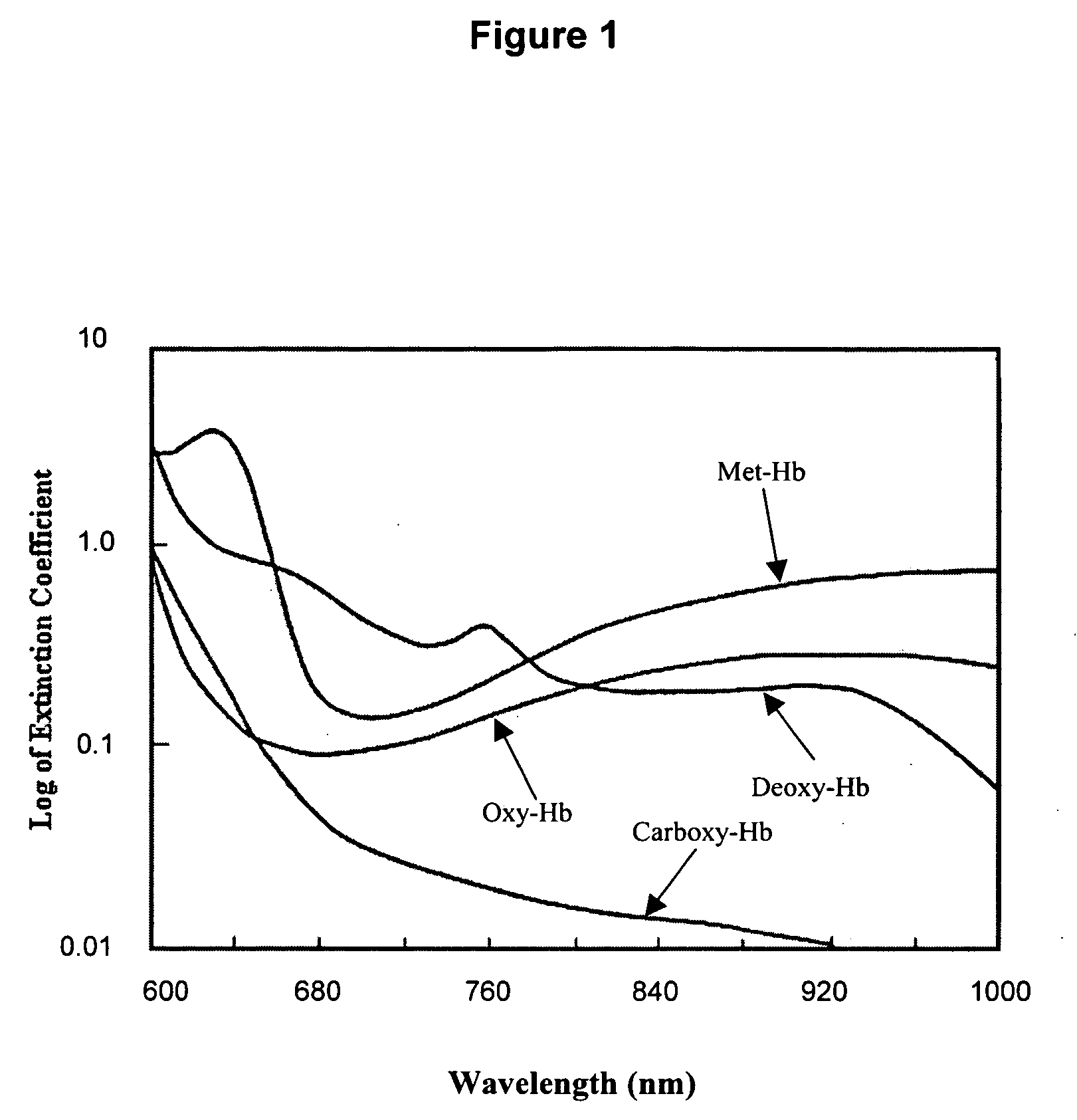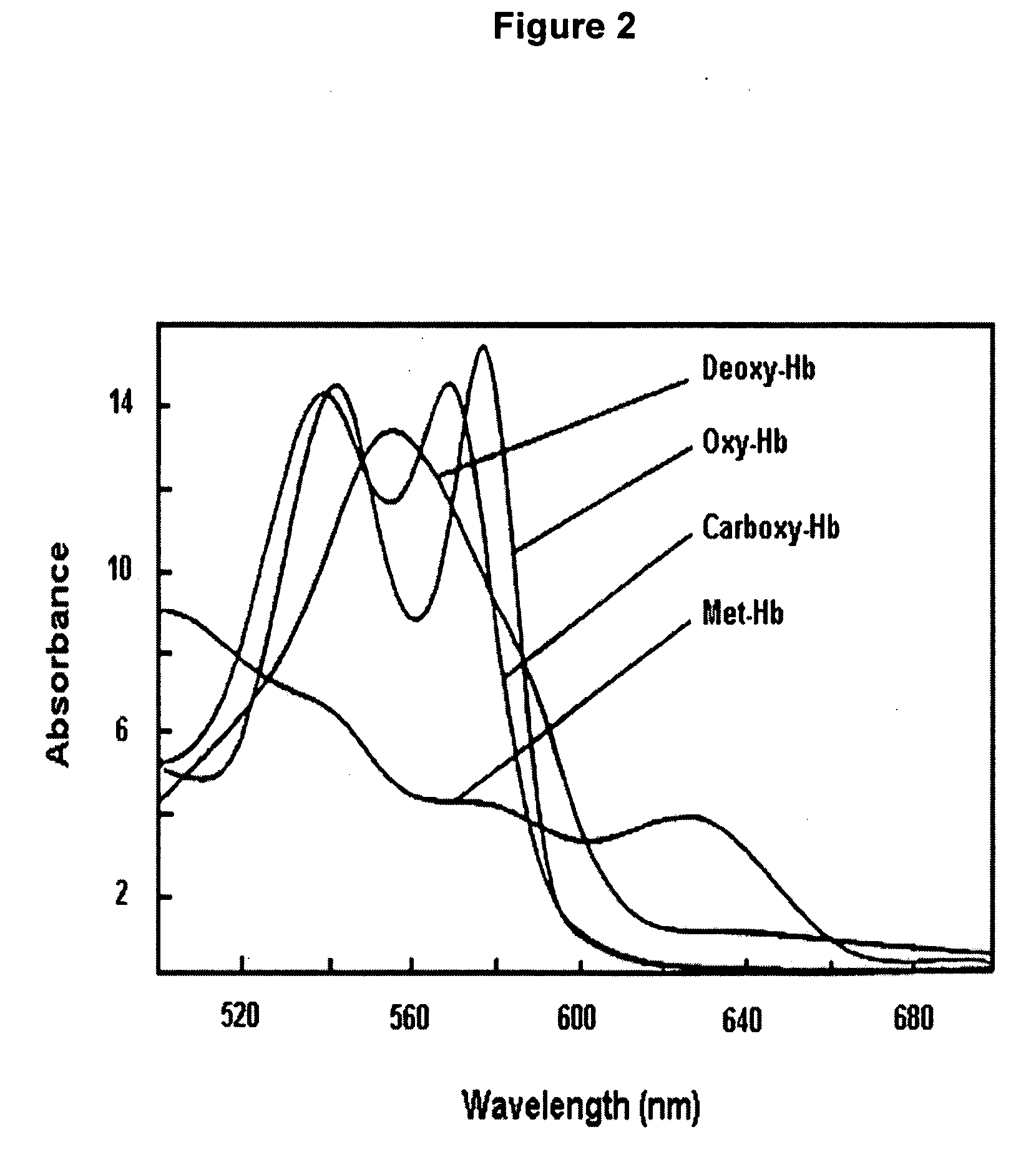Spectroscopic method and apparatus for analyte measurement
a spectroscopic method and analyte technology, applied in the field of spectroscopic measurements of analytes, can solve the problems of error in both methods, limited reagentless spectroscopic methods, and compromise sample integrity
- Summary
- Abstract
- Description
- Claims
- Application Information
AI Technical Summary
Benefits of technology
Problems solved by technology
Method used
Image
Examples
example 1
Calibration Algorithms for Hb
Examples of primary calibration algorithms for Hb using the method described in the present application are given below. It will be appreciated that the algorithms can differ when the conditions in which they are obtained differ. Although the examples below show “g / L Hb” as the dependant variable, it should be understood that the dependant variable could be any indicator of hemolysis related to Hb, for example, Total-Hb, Oxy-Hb and “Total-Hb minus Met-Hb.” The true indicator of hemolysis depends on both the reference method used to measure the indicator of hemolysis, and the substances included in the primary calibration set. As another aspect of this invention, methods for making corrections to the indicator of hemolysis are described, and whether correction is performed on the indicator of hemolysis, or the value of the indicator of hemolysis is only flagged to indicator potential error in the value, depends on the required accuracy of the indicator ...
example 2
Calibration Algorithms for Hb-Based Blood Substitutes
The following is an example of a primary calibration algorithm for Hb-based blood substitute as described in WO 98 / 39634.
Equation 7 (obtained using disposable polypropylene dispensing tips)
g / L Hb-based blood substitute=23.97(1st D A541)−76.01(1st D A558)+130.84(1st D A600)−113.61(1st D A616)+0.30
where (1st D A) is the first derivative of the absorbance measurement at the wavelength specified in nanometers.
example 3
Calibration Algorithms for Biliverdin
The following examples of primary calibrations algorithms for biliverdin are described in U.S. Pat. Nos. 6,268,910 B1 and 5,846,492 and WO 97 / 47972.
Equation 8 (obtained using blood bag tubing)
mg / L BV=−45.40(1st D A649)+323.15(1st D A731)−493.79(1st D A907)−1.14
where (1st D A) is the first derivative of the absorbance measurement at the wavelength specified in nanometers.
Equation 9 (obtained using disposable plastic dispensing tips)
mg / L BV=98.07(1st D A724 nm)−122.73(1st D A803 nm)+0.07
where (1st D A) is the first derivative of the absorbance measurement at the wavelength specified in nanometers.
Equation 10 (obtained using translucent pipette tips)
mg / dL BV=160.29(1st D A718)−206.15(1st D A781)+1.42
where (1st D A) is the first derivative of the absorbance measurement at the wavelength specified in nanometers.
PUM
| Property | Measurement | Unit |
|---|---|---|
| wavelengths | aaaaa | aaaaa |
| wavelengths | aaaaa | aaaaa |
| wavelength | aaaaa | aaaaa |
Abstract
Description
Claims
Application Information
 Login to View More
Login to View More - R&D
- Intellectual Property
- Life Sciences
- Materials
- Tech Scout
- Unparalleled Data Quality
- Higher Quality Content
- 60% Fewer Hallucinations
Browse by: Latest US Patents, China's latest patents, Technical Efficacy Thesaurus, Application Domain, Technology Topic, Popular Technical Reports.
© 2025 PatSnap. All rights reserved.Legal|Privacy policy|Modern Slavery Act Transparency Statement|Sitemap|About US| Contact US: help@patsnap.com



